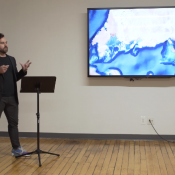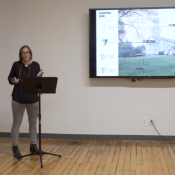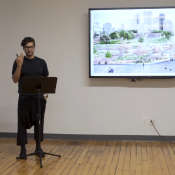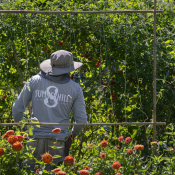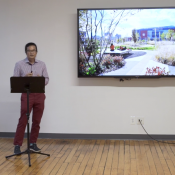Author: Kim Ferrara
Giving Back [Video]
Anchalee (Annie) Phaosawasdi of Hargreaves Jones used the platform of the Land8x8 Lightning Talks to share her experiences giving back to her community as a landscape architect and challenges the profession to create time to do so as well. While most of the projects that landscape architects serve their communities and neighborhoods, they are not always as rewarding as the larger-scale projects that are “saving the planet” or projects that are immediately rewarding.
Annie shares ways that she and her colleagues engage the community to give back and increase awareness and diversity of the profession. One such program was Gear-Up by the New York Botanical Garden that targets high school and first year college students to learn about the environment, program and projects of the Botanical Gardens, and career paths related to the environment, including landscape architecture. Another collaboration was with TIDES with Brooklyn Bridge Park and students ages 14-18. This program brings students together to complete weekly community service projects that focus on ecology, conservation, and sustainability.
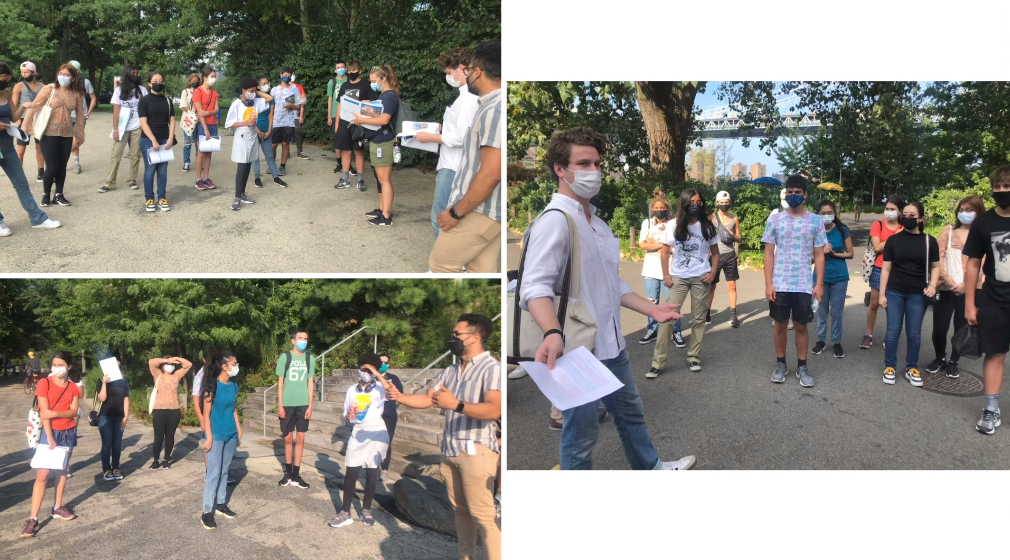
Image: Hargreaves Jones
Time, rather than money, may be more valuable and impactful for landscape architects to give back. Some ideas may include establishing think tanks, grant opportunities, externship programs, continuing education stipend, and designated research time. However, as Annie mentions, not every firm has the luxury to create such programs.
But what if we were to start small? In comparison to innovative programs in tech like Google’s “20% Time”, where 20% of paid time is dedicated to employees working on their passion projects to benefit the company, landscape architects could start with a “2% Culture” or even a “1% Culture”.
“What if per every one week, we get one paid hour that staff can dedicate to a passion project?” Annie asks. Encouraging this concept with staff could open the doors to collaboration and getting them and your firm involved in a rewarding cause or an opportunity that may have not existed otherwise. A win-win scenario could result from taking on projects like these for both the employee and the firm. When employees find purpose in their work, they tend to be highly motivated and happier in their role.
Consider creating a culture of giving back in your firm – it will help your community and will likely enhance your firm’s work and culture as well!
—
This video was filmed on September 9, 2021 in Brooklyn, NY as part of the Land8x8 Lightning Talks sponsored by Anova Furnishings.
Toward a Patchwork Ecology [Video]
“Space” in landscape architecture typically conjures up images of the horizontal plane: a canvas, sometimes blank, upon which designs may proliferate. In urban areas, greenspaces necessarily punctuate the vast expanse of hardscape as they manifest ideas of seclusion and refuge.
But what about liminal space, or areas created by the in-between of the architectural world? How about the flora that grows independently, or without human intervention, in these areas?
To David Seiter, Founder and Design Director at Future Green Studio, weaving landscape into the architectural environment through perhaps unconventional methods is the focus of his work as he explains at the Land8x8 Lightning Talks. Founded in 2008, Future Green is a design-build firm that began in New York City and now services urban areas across the east coast.
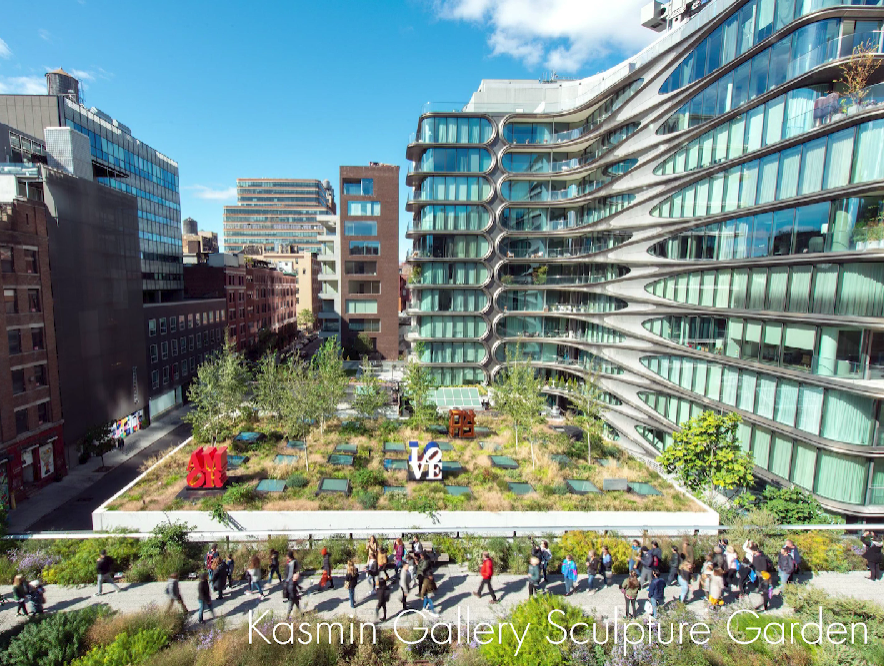
Image: Kasmin Gallery Sculpture Garden [Future Green Studio]
“[We] weave landscape into the architectural environment… Using strategies of resilience found in our spontaneous urban plants.” -David Seiter
Research is certainly a foundation. However, Seiter credits an “index of typologies” that come together to provide human ecological services. Design, research, fabrication, community collaboration, and re-envisioning ebb and flow in the harmonic creative process, oftentimes leading Future Green down a path of equal parts science and artistic expression.
The ground plane is just the beginning for Seiter’s work as designs weave up and across walls, roofs, lots, and streetscapes. In their 41 Bond project, a collection of window boxes seamlessly integrate the public façade with the private space as crawling textured plants fade into a metallic façade. The 345 Meatpacking design puts gardens above entryways, making the space feel playful, whimsical, and unexpected. “It’s really opportunistic urbanism that really looks at available territory to stitch landscape in,” says Seiter. Beyond landscape design, Future Green also takes this concept into modern art. Seiter introduces Sections of Anthropocene, a concrete core sample installation, that honors our friendly spontaneous plants.
Seiter is excited to look to the future, drawing great inspiration from science-fiction novels. He seeks to uncover more of these unexpected spaces for landscape punctuation as humanity explores below and aboveground. “Can we situate ourselves above the ground to return the earth to nature?”, Seiter ponders. He sees his inspiration formulate in the modern art world as well, inspired by art that plays on the liminal, balance, the apocalyptic, and progressive futuristic thought. As we situate ourselves to prepare for a progressive and curious future, Seiter and the team at Future Green are prepared to intervene in the unexpected.
—
This video was filmed on September 9, 2021 in Brooklyn, NY as part of the Land8x8 Lightning Talks sponsored by Anova Furnishings.
The Tao of Woke Practice [Video]
The modern design process has been formulated and repeated for decades in the landscape architecture profession. Oftentimes, it is this procedure- almost an institutionalized method of creation- that ends up disserving the same communities one vows to protect and uplift.
Since 1994, Elizabeth Kennedy, PLA and Principal of Elizabeth Kennedy Landscape Architects (EKLA), has been leading by example in how she and her team show up and make space for clients and each other. In the months following the death of George Floyd, Kennedy participated in nearly thirty juries and presentations to share her expertise in empathetic community engagement and landscape architectural practice as it pertains to African American communities and beyond.
Kennedy highlights EKLA’s project of Weeksville, New York, a historically African American neighborhood in Brooklyn, NYC, founded by freed slaves in the 19th century. She describes Weeksville as “a place of post-enslavement black history and a locus of black joy…Remarkable in asserting the communal presence of Africans in the 19th century King’s Country without symbolism.”
“[Weeksville is a place] where black people feel equity, control of their bodies, joy of presence, that this design belongs to them.” – Elizabeth Kennedy
Presenting this project multiple times has given Kennedy and the team at EKLA the opportunity to step back and re-examine their methodology many times over, to ask what it is about the project that gives them an important voice in the role of equitable design.
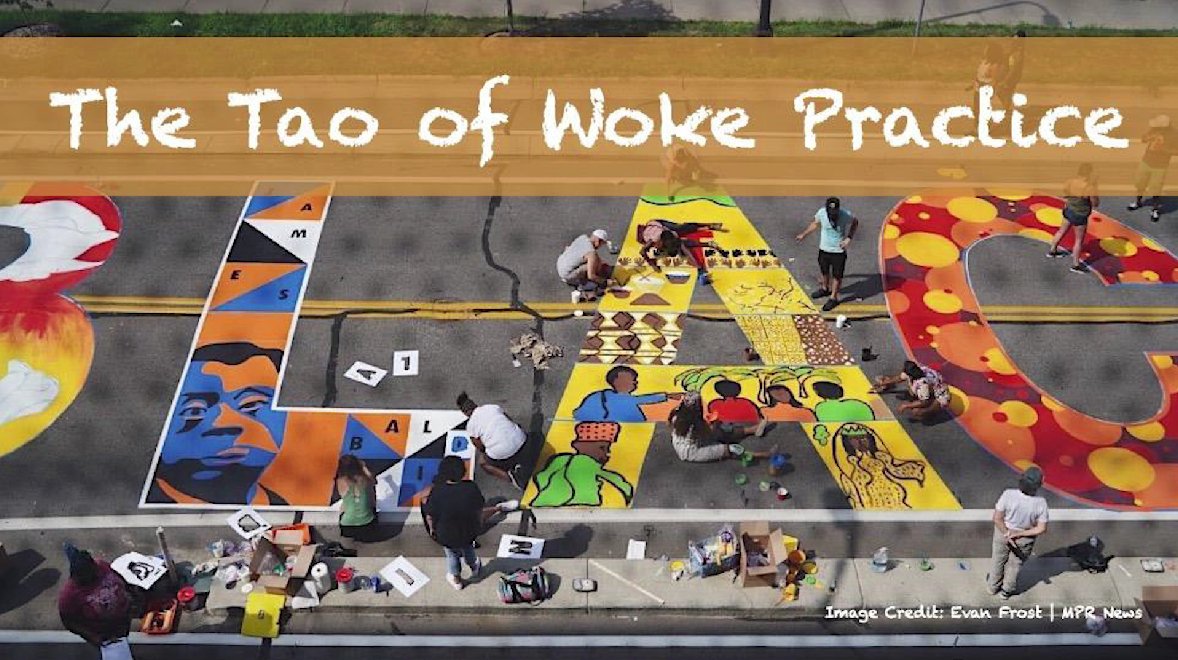
The following is a summary of Kennedy’s “The Tao of Woke Practice”, or the way of constant awareness in which landscape architects can center and practice inclusion on multiple fronts.
KNOW THAT YOU KNOW NOTHING
Be humble to the client and their experience. Do not come in with a set agenda, overlying tastes, or presumptive thoughts. Instead, we must take a position to “empty our minds as much as we can to be fully present,” says Kennedy.
BE PREPARED
One must prepare to be able to see how the client sees the world. Understanding culture goes beyond conversation. Become very familiar with how the client understands things and be ready to meet them where they are at. Listen for both what is said and not said. For example, Kennedy looks for ques that speak to private place, an area where connection happens for EKLA. Also be prepared to have solutions be fluid and flexible. “We’ve been most successful when the design solution is open-context,” says Kennedy.
ETHOS DRIVE BUSINESS MODEL
Apply your world view to your business model, not the other way around. Reframe profitability beyond the monetary and towards sustainability both for the firm overall and for each of the staff respectfully. Kennedy allows time and space by implementing salary and deadlines instead of set working hours. “It gives the flexibility to allow young and excited creative thinkers to explore” and refrain from limiting the flow of learning and suggestion.
“GET INTO GOOD TROUBLE”- JOHN LEWIS
Have these conversations one-on-one. Bring your personhood to the profession, not your agenda.
—
This video was filmed on September 9, 2021 in Brooklyn, NY as part of the Land8x8 Lightning Talks sponsored by Anova Furnishings.
Fill for Habitat [Video]
New York City’s landscape has much to offer. From its soaring skyscrapers to its vast and unique parks system, the fact that water plays a significant geographical and historical role perhaps falls to the wayside. There is a structural reasoning- even with over 520 miles of city shoreline, most is what’s considered “hard”. Bulkheads and concrete walls create a stark divide between people and the water they live on all the while diminishing critical habitat.
The importance of water does not go unnoticed to Brad Howe, PLA and Senior Associate at SCAPE. In fact, it is central to what they do. “The frequency which with we experience water and its capability of destruction is only increasing,” Howe states as he describes the hard edge’s role in poor stormwater infrastructure. Further, its these same industrial edges that put pressure on the existing “soft” shorelines, leading to their erosion and demise. SCAPE’s recent coastal work aims to reinvent New York’s edge through their Living Breakwaters project.
Living Breakwaters is a Rebuild By Design winner and was Howe’ fist project with the firm. The project goes beyond simply installing breakwaters, though, as he describes the feature as just a “moment” within a larger working system. “[It] reimagines coastal risk reduction as a layered approach” between culture, ecology, and risk reduction.
Through a massive multidisciplinary effort, Howe describes how SCAPE’s process leads to significant and accurate data collection to validate their efforts in the eyes of state, local, and federal agencies, those responsible for the protection of coastal areas.
The first step is a large effort towards existing data collection both within the site at Staten Island and from the proposed design elements. Surveys of habitat documentation, gradations of rock porosity, and recast ecological concrete are all tested for their intended individual functioning and to reach the overall goal- “[to] foster a dynamic, underwater, new form of habitat.”
Next, physical hydrodynamic modelling is performed to detect flow of water and possible sedimentation build up. Structural strength of materials is also tested, such as in cases of storm wave resiliency. When the techniques are in place, plotting the restoration approach is developed. Will oysters come, plants grow? SCAPE begins to mimic similar conditions to be expected on the breakwaters, oftentimes getting their team directly into the water to see for themselves.
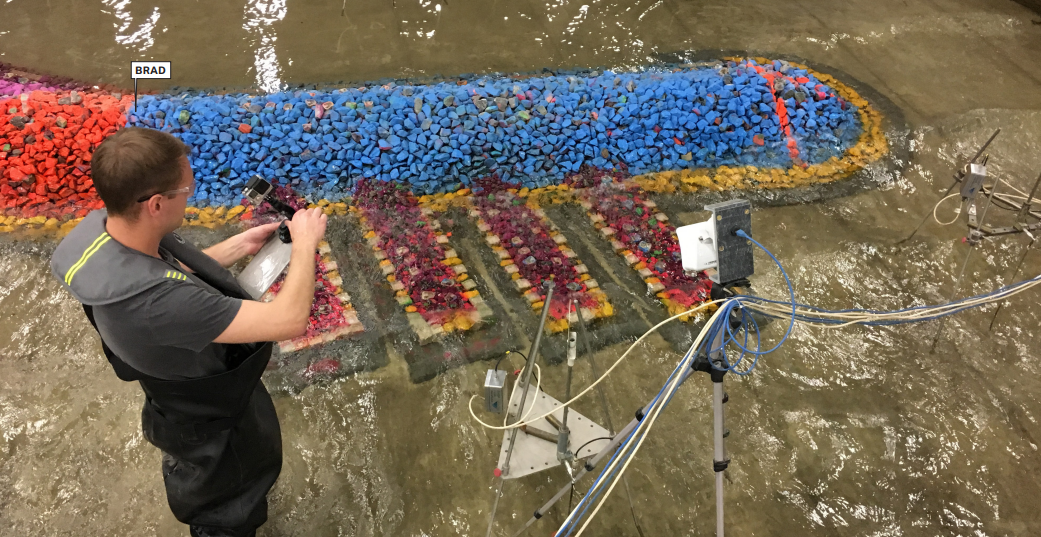
Physical Modeling | Image: SCAPE
Howe describes the next step as possibly being the most difficult- communicating with federal and state agencies. The opportunity becomes how, exactly, to present accurately and persuasively these strategies to agencies that serve to protect these waters? Ideas and goals become binders worth of paperwork- a concept that may seem tiring to most, but necessary at this point in the process. “All of that data… contributed to us kind of making a case that these parts of the breakwater designed for habitat can be nearly self-mitigating.”
With the bureaucratic petitioning complete, Howe states that designing for data collection is the last step in the Living Breakwaters process. A monitoring plan with built in control groups are created on site to compare effectiveness over the years.
SCAPE is happy to announce that Living Breakwaters is finally in its construction phase as the firm sets out to revolutionize New York’s most up-and-coming neighborhood- the sea.
—
This video was filmed on September 9, 2021 in Brooklyn, NY as part of the Land8x8 Lightning Talks sponsored by Anova Furnishings.
Designing for Decarbonization [Video]
2022 has been a year in which we are reminded in headline after headline that climate change is, in fact, not a problem to prepare for but a present and dire force to be reckoned with. The effects of increasingly frequent natural disasters and extreme temperature shifts are global issues that require innovative and imaginative solutions. Fortunately, the end is not nigh, as those same headlines are coupled with the groundbreaking news of climate capturing technologies and an increased awareness of what, exactly, our natural world is capable of.
At the Land8x8 Lightning Talks, Matthew Gindlesperger, PLA and Associate at Martha Schwartz Partners (MSP), sees the potential of these climate resiliency technologies to play a substantial role in the practice of landscape architecture. “[We are] the leading profession to face the threat of climate change.”
MSP has a reputation for artistic curiosity and genuine care to create dreamlike yet pertinent public spaces globally. Beginning with roots in the infamously famous Bagel Garden, Gindlesperger details how MSP stems out of originality and artistry. He asks, “How do we scale that level of creativity for a global problem?”
The answer is the Virtuous Cycles, a whole-system and multi-system way of thinking about landscapes that expands beyond the human level, asking how all can come together and “close the loop” between input and output of systems.

The Virtuous Cycles “utilize nature-based solutions and technologies to create self-sustaining and carbon-negative systems,” says Gindlepserger. With a focus on five components (energy, water, CO2, food, and materials), the Virtuous Cycles is the intersection of the human, groundbreaking technologies, and environmental implementations as they come to form a dream team in resilient landscape architectural implementations. The overall goal is to create a toolkit that minimizes waste, maximizes productivity, and positively impacts the environment.
MSP has been focusing the Virtuous Cycles implementation in the Middle East, a region with extreme temperatures and environments.
The Wadi Ring project deals with a dry, desert climate in which flash floods become a “vital source of water [in an area] where it is so precious,” says Gindelsperger. By examining surface hydrology, the flash floods become a system of capture and reuse in the landscape architecture design. At the same time, microclimates bloom out of the desert’s greening. The Wadi Ring, futuristic yet aesthetically relevant for the space, is calculated to meet 30% of irrigation demand through storm events alone. The rest is planned to be met through on-site wastewater recycling. Afforestation occurs over a timeline through a gradient of spaces with low to high water necessity.
MSP is also developing a Regenerative Marine and Nature Preserve in a Middle Eastern coastal context. In a space that, visually seems to be barren, Gindlesperger asks, “What could grow there?” Upon investigation, it reveals that this desert landscape is actually created by water movement, and even more ecosystems exist beneath the sea’s surface. Desert greening can be accomplished with low-input solutions to activate a dormant seed bank within the sandy soil. MSP layers on top of this artistic renditions of wastewater capsules, nanotechnology installations, and even “Eco Resorts” that playfully connect land and sea experiences.
—
This video was filmed on September 9, 2021 in Brooklyn, NY as part of the Land8x8 Lightning Talks sponsored by Anova Furnishings.
Adaptive Landscape Master Planning [Video]
How can we better prepare for the future unknown?
Martha Desbiens, Associate at MNLA, recounts how the last few years brought radical change and emphatic proactivity to the heart of her work at the Land8x8 Lightning Talks.
Desbiens reflects on how much landscape architects have improved communication skills between colleagues, clients, and communities alike during the COVID-19 pandemic. The voice landscape architects have forged in the public discourse, especially around social issues and the climate catastrophe, has been massively impactful, but “largely reactive”. Looking towards the future, landscape architects must shift communication and action to proactive, adaptive design choices and communication efforts. To provide precedent, Desbiens details how MNLA’s Smith College “20-Year Vision” Landscape Masterplan radically shifted in a reactive way to ensure positive proactive solutions in for a sometimes-unpredictable future.
Smith College of Northampton, Massachusetts set out to formulate a 20-year master plan under the direction and guidance of MNLA. In 2020, halfway through the project, COVID-19 shut down campus facilities and ultimately cut off communication with the student body. At the same time, social justice movements made students and professionals alike alert to new goals, responsibilities, and communication efforts. “Our office realized that we needed to pivot the way we think about landscape masterplans” says Desbiens.
In order to gather even more community input, Desbiens’ team launched Groundswell Magazine, a Smith College publication that helped to share what was happening with the masterplan and also allow a “constant dialogue” with the community. From that input, the Master Plan gained four new goals: Education, Inclusivity, Adaptability, and Connection.
The goals from community input meant radical change. Desbiens, without dismissing the ideas of the community, laid out graphic examples of what that change in the landscape would mean for the campus. Diagrams scaled out examples of how increasing ecologically connected spaces on campus would come at the cost of open lawned regions, something Smith had become accustomed to. “We got much tempered reactions,” she states.
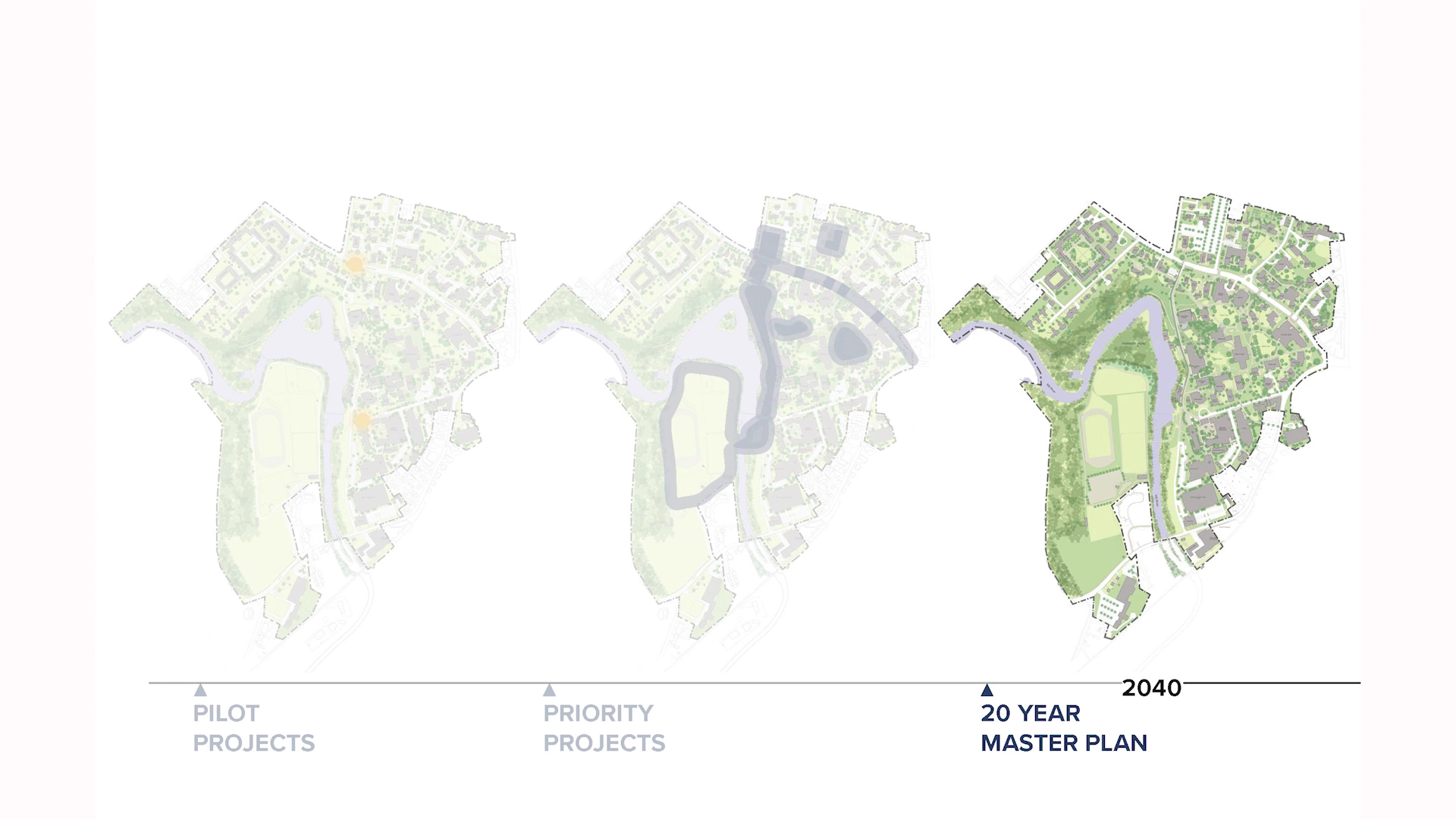
Image: MNLA
How did the 20-Year Masterplan change? Much of it came in the form of implementation and instruction. MNLA shifted gears in order to provide a detailed and highly attuned Landscape Implementation Guidelines package. Within the 300-some pages, the firm applied professional knowledge to separate the campus into relevant sections and detail an instructional guideline of how to amplify opportunity in each of the regions. What’s more is that the package included more general guidelines that speak to access, comfort, and safety. To provide adaptability in the face of an ever-changing future, the Masterplan also lays out Pilot Project Guidelines, or small, tactical implementations that tests concepts before committing to large scale changes, such as rain gardens, naturalized lawns, gathering spaces, and more.
“What I’m hoping is that we’ve given the client the tools so that they can make decisions on their own… We’ve empowered them so that their landscape follows their vision.” – Martha Desbiens
—
This video was filmed on September 9, 2021 in Brooklyn, NY as part of the Land8x8 Lightning Talks sponsored by Anova Furnishings.
Landscape as Infrastructure and Other Imaginary Tales [Video]
When it comes to resiliency infrastructure, machine-like futures seem to lie ahead for our shorelines. As sea level rise threatens our coastal communities, projects are typically driven by the works of engineers in order to create the mechanical layer of protection cities and neighborhoods need. It may seem as if landscape as infrastructure is an imaginary tale, but according to Gonzalo Cruz, Studio Design Principal, it is the core of what he and the landscape architecture team do at AECOM New York.
“There’s a lot of made-up stuff that we think through… that actually becomes realized” Cruz states in reference to the firm’s projects at the Land8x8 Lightning Talks. Driven by engineering, the team is juxtaposed to design a landscape in which the technical infrastructure necessary for resilience can blend seamlessly into the functioning and flourishment of existing communities. For Cruz, it is about taking advantage of landscape opportunities inside these large-scale and non-human-centric projects.
Coastal adaptation infrastructure makes up the bulk of Cruz’s work. Many projects are adaptations of the Obama administration’s Rebuild By Design initiative which Cruz credits for changing the way designers viewed their role in fighting climate change. The Brooklyn Bridge and Montgomery Central Resilience project, located in Lower Manhattan, is a spinoff of said program and a small piece of a larger Manhattan masterplan. The team was posed to create a line of floodwater protection that shields as much of the existing region while maintaining public waterfront access.
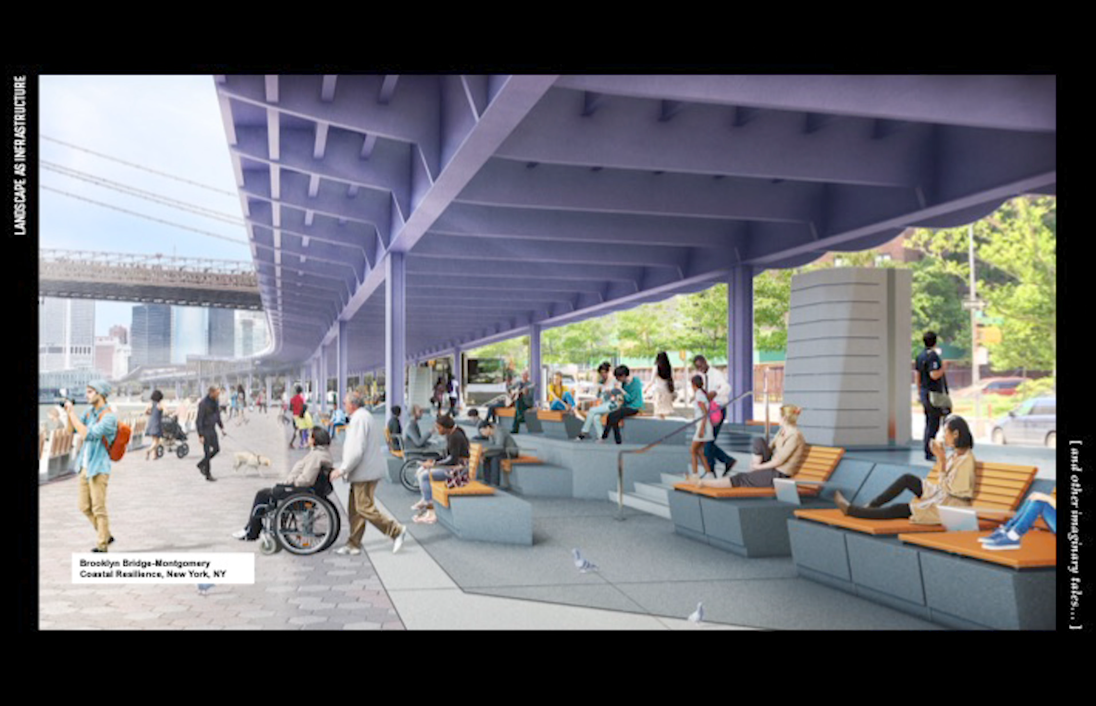
Image: AECOM
“It’s a very dynamic waterfront to begin with” Cruz states as he depicts the variety of functions found along the shoreline. The insertion of a flood wall, one that is raised and lowered accordingly, meant current waterfront access was compromised without the input of landscape architects. The result creates a layered and diverse community waterfront by the insertion of flexible public space and urban amenities atop and around the mechanism. The storm wall, when lowered, is the main walkway connection for all programming elements, including workout equipment, seating arrangements, and even swings.
Another exemplary project introduced by Cruz is the Battery Park City (BPC) Resiliency Project’s Wagner Park redesign. Wagner Park, set to be inundated by higher waters, was identified as a key for adaptation infrastructure. “We looked into the legacy of how BPC was built over time… There’s nothing it can’t do” says Cruz. To merge the legacy of the park with current and future infrastructure needs, the team forgoes a sea wall by creating a transition area that gradually brings height to the park. The ground plane is thus extended and much of the traditional organization maintained. Yet, the park gets a fresh face and unique programming experiences in which higher ground is not seen as a barrier but instead becomes a part of the experience of place.
Landscape as infrastructure once seemed like an imaginary tale, but it is the work of designers like Cruz that bring big ideas to life. Today landscape architects serve a critical role in not only providing resiliency in terms of the technical but also the emotional and humanistic- a position unlike any other profession. “It’s nice to be curious about these things every day” says Cruz.
—
This video was filmed on September 9, 2021 in Brooklyn, NY as part of the Land8x8 Lightning Talks sponsored by Anova Furnishings.
A Love Letter to the Outdoor Internship: The Importance of Experiential Learning
It was early spring when I sat down with the team at Summerhill Landscapes.
It had been my third semester of remote pandemic learning, or one and a half years of my college experience put on “pause”. The confusion, disappointment, and cabin fever was amounting to an agitated escapism inside of me that I knew I couldn’t quell with a vacation or a walk in the park.
I wanted to get my hands dirty, to put in work that was physically taxing- the kind that leaves you sore at the end of the day, a rewarding reminder of a job well done. The kind of work that I would not have seen inside the traditional classroom let alone within the confines of my new virtual world. I wanted to be involved in landscape architecture in a way that connected me back to the earth, to others, and to the reality of the profession.
“It’s going to be hard work,” Brendan O’Dwyer, Vice President of Summerhill said to me over Zoom. “Long days, long weeks… Are you positive you are up for that?” I appreciated the honesty and gave him a definitive “yes”. Within a week, I had accepted an internship position at Summerhill specializing in kitchen gardens and edible horticulture, my thesis subject. I felt an internal valve release knowing this would not be a summer of blue light glasses or Adobe Suite.

Summerhill’s main office in Sag Harbor, New York
Declan Blackmore founded Summerhill Landscapes in 1993 after having an experiential internship of his own. With a background in horticulture and familiarity with the Hamptons, Declan moved from Ireland and sought to offer the same opportunity for hands-on education to other Irish students in the field. Over the decades, Summerhill has grown into an international presence, hosting students from China, England, Spain, Brazil, and more, allowing them to determine how the internship program can meet their personal experiential and educational goals. I was fortunate enough to have my stay be during an exceptional time in the pandemic which allowed, at least, US students to come to the company.
“There’s no way to separate the impact of interns on our company from Summerhill’s story as a whole. It’s not a stretch to say the internship program is the foundation of our business.” -Tom Volk, Director at Summerhill Landscapes Inc.
That May, I packed my bags and moved to the Hamptons, the wealthy enclave of Long Island that is a summer host to international-level wealth along with some of the most gorgeous landscapes both designed and natural. Within two days, I was out on the job site planting dozens of perennials in a flower garden that’s scale and grandeur was unlike anything I had ever seen before. The dedication and discipline it took to install and maintain these properties was never something I had considered in school. As a landscape architect major with a passion for high-end residential, I realized just how important my job was both to the present moment’s needs and also to making me a well-rounded emerging professional.
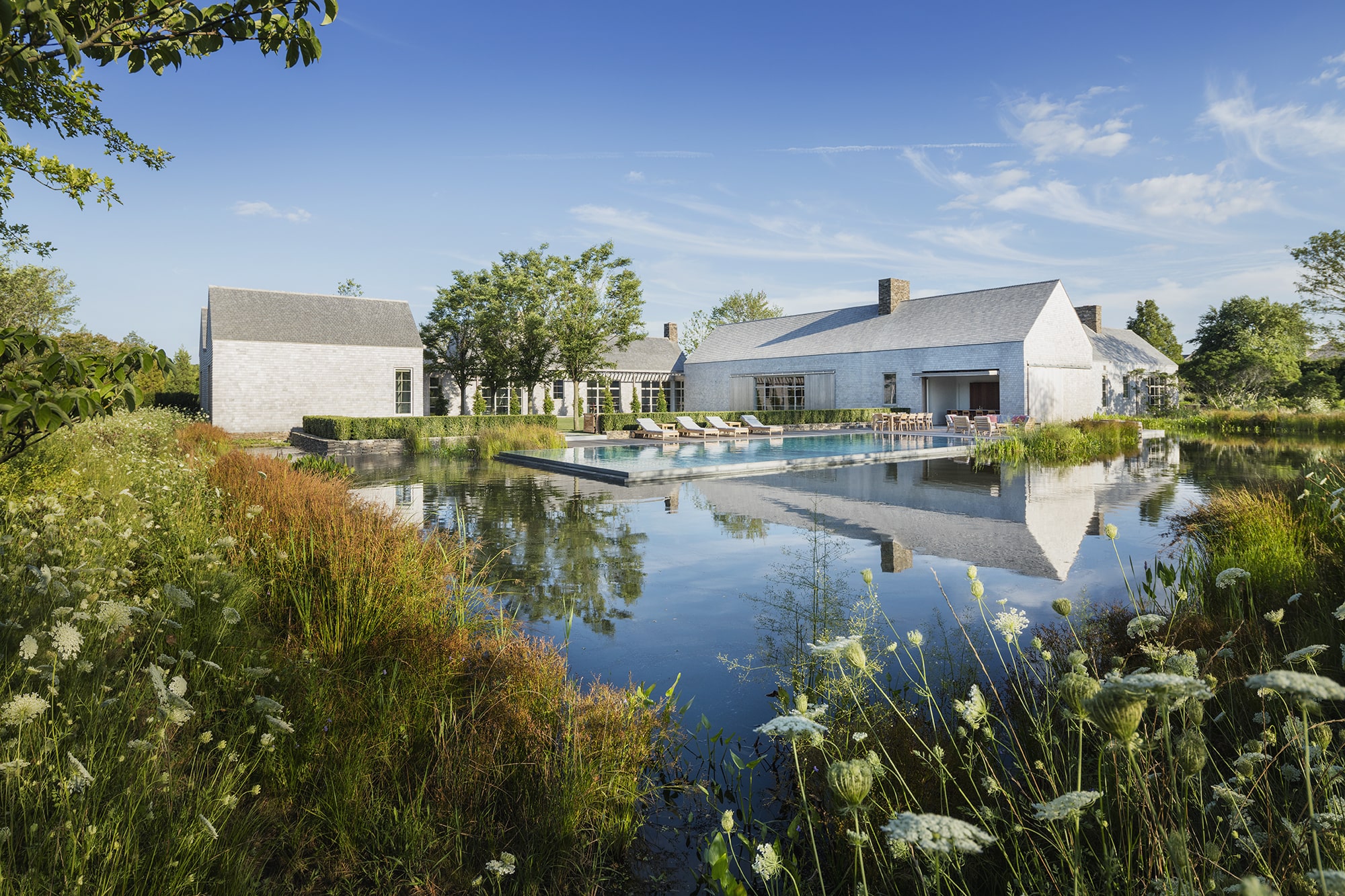
Internships at Summerhill expose emerging professionals to all realms of the construction, installation, and maintenance processes within the setting of high end residential landscape architecture.
There is something special about Summerhill’s internship program and that is its ability to lay the groundwork for profound and everlasting memories. I moved onto a property owned by the company that hosted two intern houses (or 9 interns total), a shared lawn and grill deck separating the two. It took not one week for us to peek out of our rooms, greet new arrivals, and begin our journey together. Our bond began with shared responsibility- We all awoke at 5am, worked hard in the sun within our respective internships, and pulled in home for sunset. It was not long before we were heading out on weekend trips to the North Fork, splurging on a fancy night on the town, or simply grilling vegetables to share on a Wednesday night.
Although we departed in July of 2021, I still talk to them every week and reflect fondly on the idea that our smiling group photo hangs on the wall of the intern house next to the generations that came before us. A rite of passage after a summer of dedication. I can say that my experience is not exceptional at Summerhill- more than 30% of their current full-time staff were interns themselves.
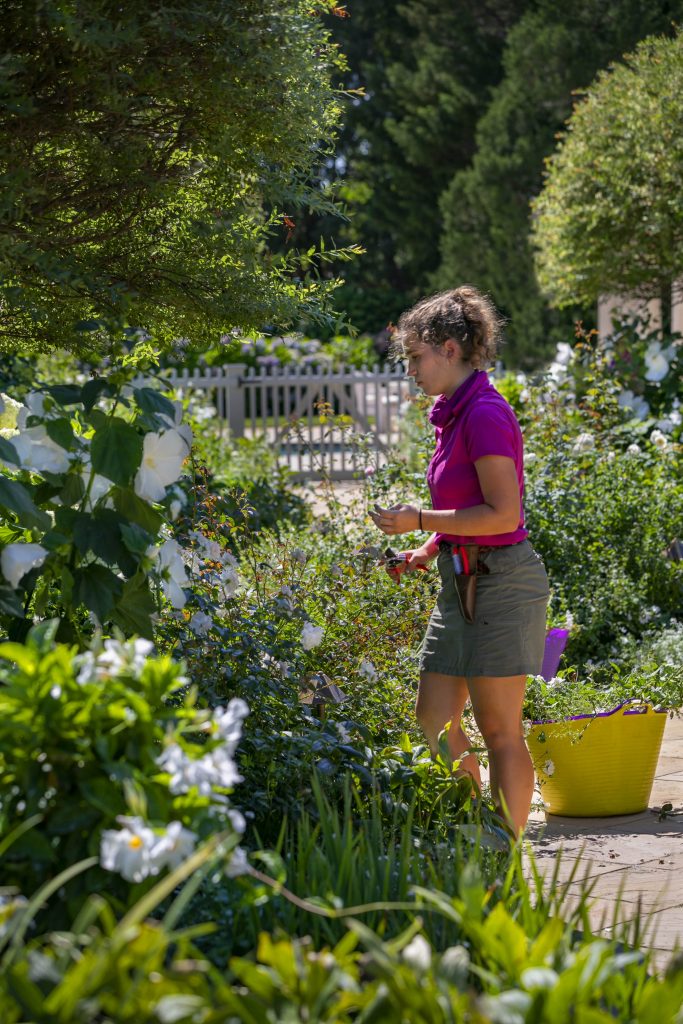
A Summerhill intern learns directly from team leaders in order to meet their own educational goals with tasks at hand.
I won’t say that office and design internships are more or less important than horticultural and construction internships, or that all outdoor internships are as picturesque in essence as my experience, but I will argue that the latter is absolutely necessary for landscape architecture students. If the immersive, hands-on experience does nothing else, it will teach you an invaluable life lesson that, in my opinion, improves your quality of life in almost every sphere- grit. The soil under your fingernails and sweat on your brow does wonders for strength of character and resilience to life’s inevitable rough patches.
The new year is upon us and students across the country will be submitting their applications for internships as soon as they can shake off winter break. If you are a firm or individual taking on the task of aiding the next generation’s education and exposure in landscape architecture, make sure to get your emerging professionals out in the field. See if there is even a day they can lay out planting plans, get some time in with a trowel, or deadhead some perennials. Introduce them to the contractors and project managers who bring your ideas to life. The variety is not only exciting but invaluable to the experience they have with you and the lessons they’ll take into their career.
Grounding Stories in Place [Video]
Taewook Cha, founding principal and landscape architect of Supermass Studio, discusses how stories in the landscape are the key to professional excellence at the Land8x8 Lightning Talks. With 25 years of experience, Cha notes how landscape architects often use phrases and terms that seem like vaguely grand yet promising gestures. “Urban Life Forms” and “Exemplary Environments” seem like shining examples of design integrity but lack clear meaning and impact. Thus, the outlook of landscape architecture may not fall in the pinpointing of the terms that buzz the community.
“There were times where we believed the future of landscape architecture depended on our ability to conceptualize and theorize abstract words, but the future relies on our ability to relay people’s stories through the landscape we create.” – Taewook Cha
When asked to present on Big Data and the Metaverse on behalf of the Korean Landscape Architecture Association, Cha openly admits “I know nothing about [it]”. He forgoes emphasizing places as averages of people-based information and instead focuses on the stories communities and individuals create within, around, before, and after a place. It is the qualitative experience of place that is the cornerstone to future practices over the quantitative data that is interpreted from these very human interactions. In other words, storytelling with landscape architecture is the way to create meaningful spaces.
Cha details three examples from the Supermass Studio team that depict storytelling in a variety of ways. The Mulberry Commons Park of Newark, NJ, a space which has undergone multitudes of change with its downtown context, was reprogrammed to support play and connection for all ages. Cha notes that the Making Strides Against Breast Cancer walk held in Mulberry Commons Park was a great showcase of how people make a space their own with family stories physically written for all to read.

Image: Supermass Studio
Notable designs such as the LaGuardia Airport and Rutgers Honors Living-Learning Community by Supermass were projects that both encapsulated and provided the groundwork for a memorable experience. Terminal B, designed to reflect the iconic feel of NYC parks, uses paving details and color palettes to mimic the contextual story visitors arrive to. The piazza design at Rutgers, the most diverse American university, proudly showcases welcoming and bold words in the respective languages of its students.
Even getting users a part in the process is a piece of storytelling. Cha’s Swingtones project in Strafford, NH directly involved youth campers in the process of these “swing-chime” installations. The landscape story, in this instance, started before the space was even finished.
In summary, Cha aims to emphasize the importance of the human experience in the future of landscape architecture and the rise of the Metaverse. Designs, to him, are not complete until the stories of community are layered and shared on top of the physical place.
—
This video was filmed on September 9, 2021 in Brooklyn, NY as part of the Land8x8 Lightning Talks sponsored by Anova Furnishings.



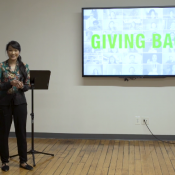


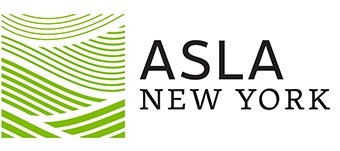
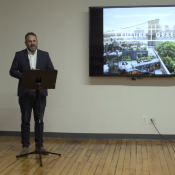

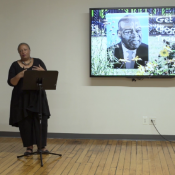

![Fill for Habitat [Video]](https://land8.com/wp-content/uploads/2022/07/land8-cover-175x175.png)
![Fill for Habitat [Video]](https://land8.com/wp-content/uploads/2022/07/land8-cover-80x80.png)
